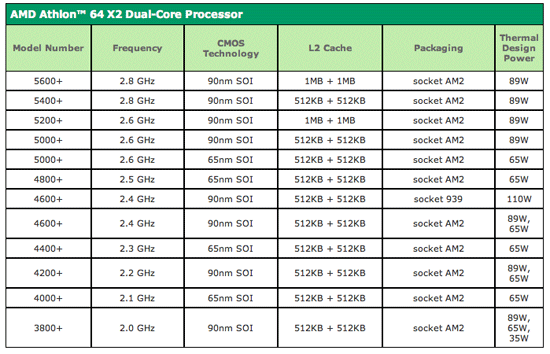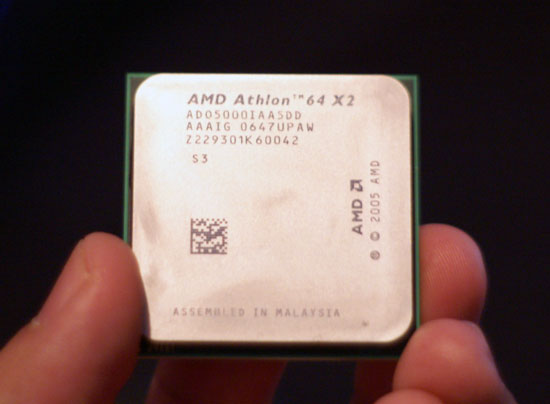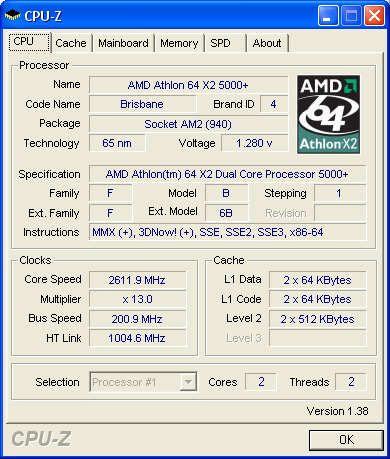AMD's 65nm Brisbane Core Previewed: The most energy efficient AMD CPU to date
by Anand Lal Shimpi on December 14, 2006 6:08 PM EST- Posted in
- CPUs
When Intel launched its Core 2 line of processors we saw AMD's performance and power advantages vanish into thin air but the comparison, at least on the power side, wasn't totally fair. Intel had been shipping desktop processors on its 65nm process for months prior to the launch of Core 2, while AMD's Athlon 64 X2s were still built on a 90nm process. We had no way of telling how much of Intel's power advantage was due to a more efficient architecture or simply smaller, cooler running transistors. Up to now, AMD has been penalized twice in all Core 2 vs. Athlon 64 X2 comparisons; AMD's new micro-architecture won't debut until next year and neither will 65nm in any great quantities.
Technically in-line with roadmaps, AMD just introduced and announced shipment of its first 65nm cores: codenamed Brisbane. Availability is another story entirely, as it's looking like we won't see any real quantities of these things until Q1 2007. Right now AMD's Brisbane chips are strictly OEM only and AMD wasn't able to give us an indication of when to expect retail/channel availability. Of course we wouldn't be talking about this today if we didn't have a chip, which we do, but for all intents and purposes you can consider this a preview of what to expect in the new year from AMD's first 65nm chips.
AMD announced its Brisbane lineup earlier this month, the chips and basic specs are listed below:

As you can expect, AMD is pricing the 65nm chips in line with its 90nm offerings to encourage the transition. Die size and TDP have both gone down to 126 mm^2 and 65W across the line. As AMD improves its 65nm SOI process you can expect to see even lower wattage parts, but for now all of the 65nm chips are rated at 65W TDP.
Transistor count remains unchanged at 154M as there is no new functionality or cache introduced with the move to 65nm. Once again, we will have to wait until around the middle of 2007 before we'll see any major changes to AMD's architecture.

The chip we received was AMD's 65nm Athlon 64 X2 5000+ and from the outside, it looks just like a normal X2. The only way to tell that this is a 65nm chip is by looking at the OPN.

Armed with the chip and its $301 price point we set out to compare its performance, power consumption and power efficiency to AMD's other 90nm CPUs and the closest price competitor from Intel: the Core 2 Duo E6600 priced at $316.










63 Comments
View All Comments
dev0lution - Friday, December 15, 2006 - link
Now that both companies claim to offer "platforms" it'd be interesting to see an Intel 965 board vs. an ATI board being used in these benches. Not sure that the NVIDIA models were the best choice here, especially since their not apples to apples on generation and power consumption.poohbear - Thursday, December 14, 2006 - link
im quite shocked to see the gaming performance advantage @ 1600x1200!!!! is'nt the cpu removed as a performance bottle neck @ such a high resolution? its all about the gpu horsepower @ that resolution no? can't believe a cpu can show a 25fps diff @ 1600x1200?!?!?JumpingJack - Friday, December 15, 2006 - link
Some more research here is in order. The G80 GPU, commonly known as the 8800 GTX or GTS on the market, has taken graphics performance to a new level. All of the reviews that used an AMD FX-60 or 62 CPU clearly showed throttling back to the CPU in many if not most cases, only at the highest possible resolutions/AA + FSAA did the scaling turn back on with an FX-60. The X6800 released the full potential of this card.
The difference in framerate you see bettweent he 5000+ and the E6600 is that the E6600 is has pushed the bottleneck further ahead -- simply because the E6600 is a better gaming CPU.
Tom's did a good article titled: The 8800 Needs the Fasted CPU.
In essense, even for a single card solution, an AMD CPU is not a good match for this card.
Makaveli - Friday, December 15, 2006 - link
The reason for the 25fps difference must mean the Geforce is more cpu bottlenecked on the AMD platform than the intel one.U gotta remember the 8800GTX is an insanely fast card, and is still bottlenecked on Conroe systems.
JarredWalton - Friday, December 15, 2006 - link
This is why back at the Core 2 Duo launch we talked about CPU performance using games running at 1280x1024 0xAA. When a faster GPU comes out and shifts the bottleneck to the CPU (as has happened with the 8800 GTX), saying "Athlon X2 and Core 2 Duo are equal when it comes to gaming" is a complete fabrication. It's not unreasonable to think that there will be other games where that ~25% performance difference means you can enable high quality mode. Company of Heroes is another good example of a game that can chug on X2 chips at times, even with high-end GPUs.XMan - Thursday, December 14, 2006 - link
Do you think you might have gotten a higher overclock if you weren't running HTT at 1125MHz?!?Sunrise089 - Thursday, December 14, 2006 - link
The chart on page one claims to have pricing info. There is none as far as I can see.JarredWalton - Friday, December 15, 2006 - link
Fixed. :)RichUK - Thursday, December 14, 2006 - link
Same old sh!t. It's nice to see AMD finally kicking off their 65nm retail chips, but lets see this new core for God sakes.They're lacking big time, this really is sad. **Thumbs-Down**
Stereodude - Thursday, December 14, 2006 - link
How's a chip that uses less power run hotter? On the last page the 65nm X2 5000+ hit 51C under load, lower than any other chip, but it uses more power than any chip except the 90nm X2 5000+. How's that work?